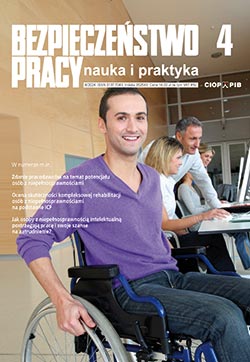Selection of eye and face protection equipment for welders
dr inż. GRZEGORZ OWCZAREK, dr inż. JOANNA SZKUDLAREK
The article presents a discussion on the general rule of selecting proper personal protection equipment designed to protect eyes and faces as well as in the context of welding. Lists of hazards occurring at the welder's workplace, characteristics and types of eye and face protection used in these conditions were presented. The article also aims to help out readers in interpreting the contents of standards containing guidelines connected to the selection of eye and face protection equipment.
Presentation of a mobile application for the assessment of exposure to UV radiation in the vicinity of arc welding
mgr inż. MARIUSZ WISEŁKA, dr hab. inż. AGNIESZKA WOLSKA
Ultraviolet radiation (direct and reflected) can pose a health hazard to bystanders working or in the vicinity of arc welding. Radiant exposure of UV radiation (product of the irradiance and exposure time) of the skin or eyes of a person staying in the welding room, even in areas away from the arc or protected by welding screens, may exceed the values of the maximum permissible exposure (MDE). Hence, it is important to design workstations located in the welding room in such a way that other workers are not exposed to excessive UV radiation. The developed mobile application can help with this. It makes it possible to estimate the value of the irradiance and the allowable exposure time of an employee staying in any place in the room, as well as to model the setting of welding shields so as to reduce the occupational risk to a low level. The condition is to have measurement data of the irradiance for a given welding process and to enter them into the calculations in the application. If the user does not have such data, he can purchase a measurement database for various welding processes developed at CIOP-PIB and select the measurement result for a given welding process.
The developed application ( without a measurement database) is available free of charge on the CIOP-PIB website could be an important tool for monitoring threats or their sources and communicating about them.
Medical waste management
dr MAŁGORZATA GOŁOFIT-SZYMCZAK, prof. dr hab. n. med. RAFAŁ L. GÓRNY
The basis for the proper management of the medical waste (especially at work) is done through their appropriate segregation and disposal. It is estimated that in Poland medical waste is generated by approximately 40 thousand business entities. The article shows the current classification of medical waste, as well as characterizes sources of its creation and means of their collection and storage. It also introduces the readers to the knowledge about the handling of medical waste in the light of the applicable Polish and European laws, including, among other things, transportation and dispisal.
The impact of age and gender on the functionality traits related to precision of carrying tasks out
prof. dr hab. inż. DANUTA ROMAN-LIU, dr JOANNA MAZUR-RÓŻYCKA, dr TOMASZ TOKARSKI
The purpose of the research presented in this article was to assess the impact of age and gender on functional features associated with precision and speed of task performance. The study involved two 120-person groups: the younger aged 20-30 and the older aged 55-67 years old. Variables describing the quality of precise actions, eye-hand-eye coordination and eye-hand coordination in the cross-test were measured. In the variables of all tests, the values varied according to the age and gender of the subjects. The smallest differences between men and women occur in the variables of the eye-hand- leg coordination test. The results clearly show that the performance of tasks requiring precision and speed of action is conditioned by age, and in the case of some variables also by gender.




























